A taste like happiness
We’re back from winter’s break. Our farmhouse remains a weather-beaten outpost in an ocean of snow. But since our return, signs are stirring that the blanket of frozen white will soon recede. This week, during a still and brilliant afternoon spent pruning raspberry bushes, a flicker of blue flashed in the thicket at the end of my row. A blazing blue – entirely unlike the hazy low mountains framing the Quabbain Reservoir on the horizon, and a world apart from the clear winter sky. We saw a second flash, then a third.“Welcome back Bluebirds!” exclaimed our teacher Carlen Rigrod, who trumpeted their arrival as promise of an early spring.As I write, hardwoods everywhere are waking up to the songbirds’ return too. All winter, maples, birches and oaks have been hanging onto last fall’s photosynthetic energy, storing it as sap in their roots and the heart of their trunks. And as the days get longer and the temperature hovers just so, a mechanism that no one truly understands stirs deep inside and sets the sap in motion. During the warmer days, the sap flows upward, waking up buds on the tree’s bare limbs. When night descends and cold returns, the sap retreats to its hiding places down below, which helps safeguard the tree’s vascular tissues against freezing.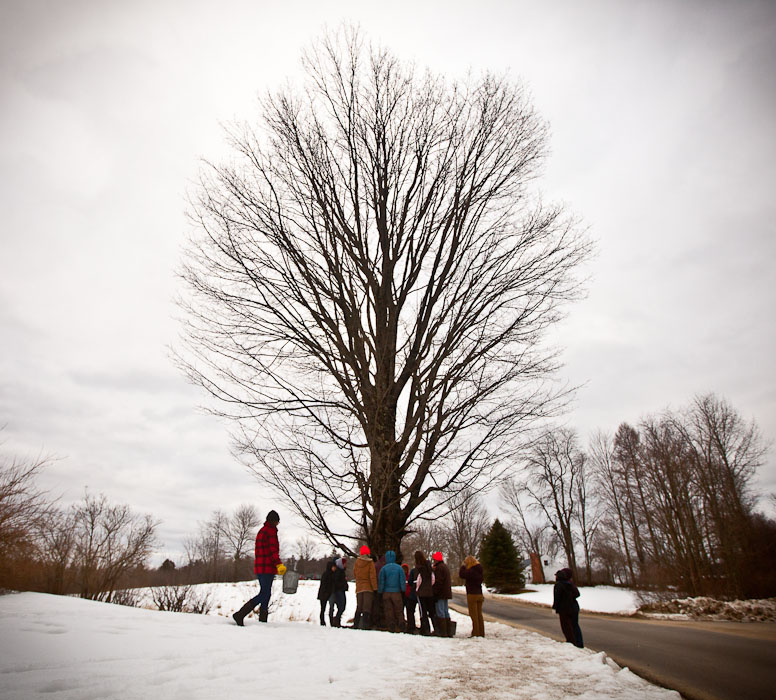 This is sugaring season – the time of year when we humans spend vast quantities of energy finding, collecting, moving, boiling and bottling sap to make not-so-vast quantities of syrup. As we learned this Friday, nearly all deciduous hardwood trees make sap that contains some amount of sugar. But Sugar Maples are the sucrose champions. Their sap is 2% sugar, which admittedly isn’t overwhelming, but it’s enough to distinguish them as the primary source of sweetness on which our pancakes and waffles depend.Standing before a curiously partitioned vat of boiling sap, hydrometer in hand, and half hidden by the plumes of sweet smelling steam filling the Farm School’s sugar shack, funnyman and naturalist Reid Brant laid out how the long process works:
This is sugaring season – the time of year when we humans spend vast quantities of energy finding, collecting, moving, boiling and bottling sap to make not-so-vast quantities of syrup. As we learned this Friday, nearly all deciduous hardwood trees make sap that contains some amount of sugar. But Sugar Maples are the sucrose champions. Their sap is 2% sugar, which admittedly isn’t overwhelming, but it’s enough to distinguish them as the primary source of sweetness on which our pancakes and waffles depend.Standing before a curiously partitioned vat of boiling sap, hydrometer in hand, and half hidden by the plumes of sweet smelling steam filling the Farm School’s sugar shack, funnyman and naturalist Reid Brant laid out how the long process works: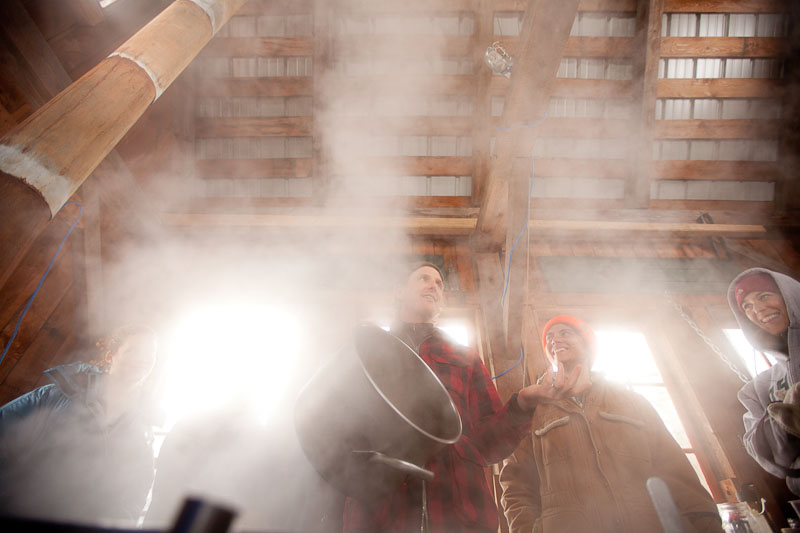 Sugar mapling is a partnership between foodie mad scientists and tree-dwelling magical elves, Reid ventured to the laughs of the gathered students. His explanations then tended quickly toward the scientific, but even after our lesson, I still see room for magic in this mysterious process.Here’s how we get the sugar from the elves and into our belly:
Sugar mapling is a partnership between foodie mad scientists and tree-dwelling magical elves, Reid ventured to the laughs of the gathered students. His explanations then tended quickly toward the scientific, but even after our lesson, I still see room for magic in this mysterious process.Here’s how we get the sugar from the elves and into our belly: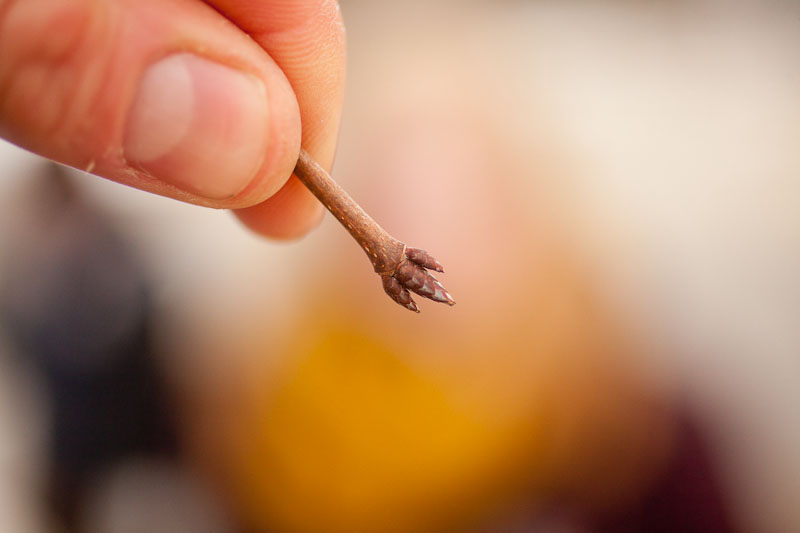 Find It: Task one is identifying the right trees to tap. You can tap other maples (such as Norway and Red Maples) and get useable sap, but their sugar content is lower, which prolongs the whole process. And if you do tap a Red (as Reid once did), be prepared to wince at every encounter with an experienced sugar mapler, who will seek you out to ask you what the heck you were thinking. But wintertime tree identification is tough because the most telltale characteristic of a tree – its foliage – is missing. So here’s the best advice: Identify the trees in summer and mark them. Genius. But if you don’t do that, the next best thing to is to cheat. If you live in an agricultural community, chances are most mature sugar maples have been tapped before, so look for the scars. They look a look like bullet holes. And if you can’t find the scars and you were too busy during the summer playing Farmville on Facebook to mark trees, your last option is to look at the terminal buds on the end of each branch. Red Maple buds are short and knobby and grow at 90 degrees from the stem. Sugar Maples are pointy and sleek and are fixed at 45% degrees.
Find It: Task one is identifying the right trees to tap. You can tap other maples (such as Norway and Red Maples) and get useable sap, but their sugar content is lower, which prolongs the whole process. And if you do tap a Red (as Reid once did), be prepared to wince at every encounter with an experienced sugar mapler, who will seek you out to ask you what the heck you were thinking. But wintertime tree identification is tough because the most telltale characteristic of a tree – its foliage – is missing. So here’s the best advice: Identify the trees in summer and mark them. Genius. But if you don’t do that, the next best thing to is to cheat. If you live in an agricultural community, chances are most mature sugar maples have been tapped before, so look for the scars. They look a look like bullet holes. And if you can’t find the scars and you were too busy during the summer playing Farmville on Facebook to mark trees, your last option is to look at the terminal buds on the end of each branch. Red Maple buds are short and knobby and grow at 90 degrees from the stem. Sugar Maples are pointy and sleek and are fixed at 45% degrees.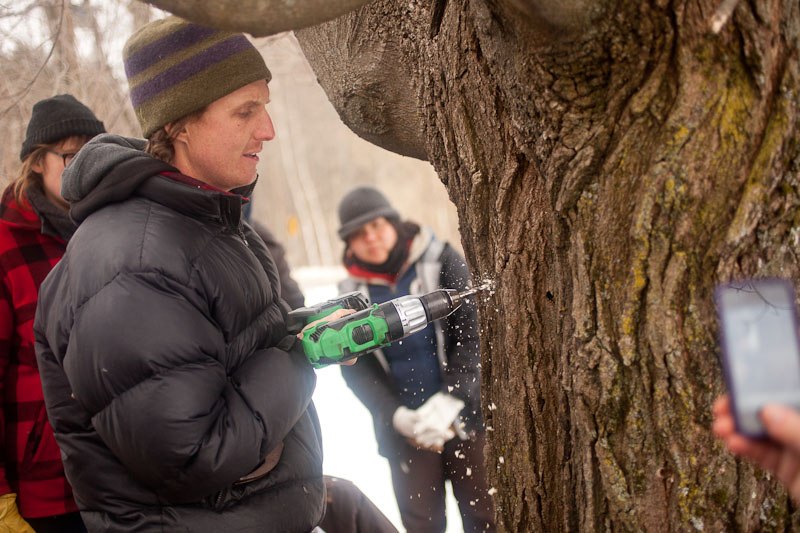 Tap It: Using a 7/16” bit, drill a 1.5” hole in a healthy area of a tree without any dead wood above or below and a generous distance from other tap scars. A tree that is 10-12” in diameter can support one tap without harm. Beyond that, you can add another tap for every additional 7-9” in the tree’s girth. Observing these rules is what allows us to continue our parasitic ways without killing our hosts.“If you want to keep coming back to the well…” Reid cautioned, trailing off at the end.My mind filled in the rest: Don’t piss in it.Insert at tap, attach a galvanized-steel bucket, cover it with a lid to keep out debris and wayward mice, and come back every day to collect the sap.
Tap It: Using a 7/16” bit, drill a 1.5” hole in a healthy area of a tree without any dead wood above or below and a generous distance from other tap scars. A tree that is 10-12” in diameter can support one tap without harm. Beyond that, you can add another tap for every additional 7-9” in the tree’s girth. Observing these rules is what allows us to continue our parasitic ways without killing our hosts.“If you want to keep coming back to the well…” Reid cautioned, trailing off at the end.My mind filled in the rest: Don’t piss in it.Insert at tap, attach a galvanized-steel bucket, cover it with a lid to keep out debris and wayward mice, and come back every day to collect the sap.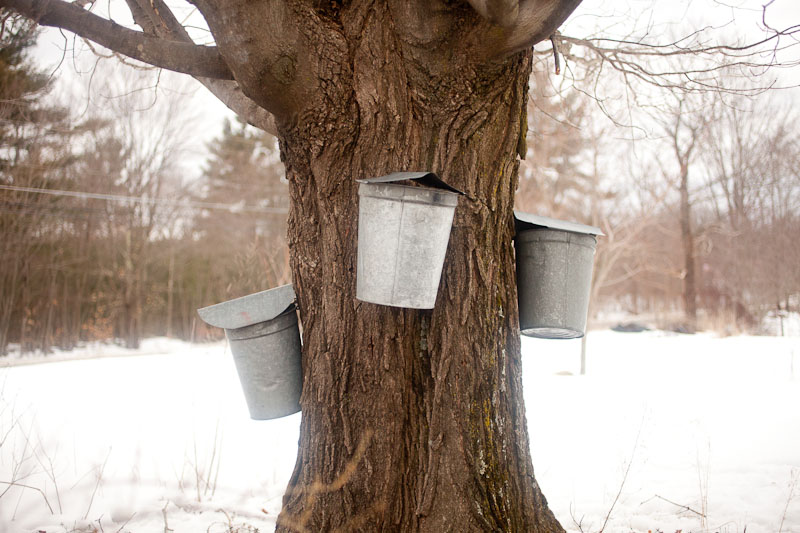
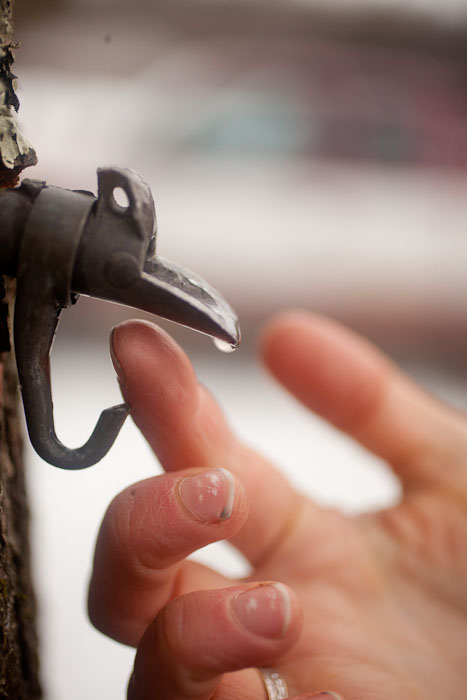 A few other things to note: You’ll generally get more sap from a tap on the southern-facing side of a tree (it’s sunnier and warmer, so the sap flows the longest here). And even though collecting sap is the first step of many, it turns out you can stop the process at this point. Dina, who was with us in all her 7-months-pregnant glory, eyeballed the clear, cold watery sap during Reid’s hour-long presentation. Craving something other than beer for the first time, she downed a whole glass the second we left the Sugar Shack. It’s ever-so-slightly sweet and surprisingly refreshing – something they’ve already got figured out in South Korea.Boil the Heck out of It: Once you’ve collected enough sap for one batch, it’s time for the real work to begin. Forty-to-one: that’s the ratio of sap to syrup, which means that to produce one gallon of the sweet stuff, you need to boil off 39 gallons of water. This is accomplished using an evaporator – a specialized metal pan atop a wood-fired stove called an arch.
A few other things to note: You’ll generally get more sap from a tap on the southern-facing side of a tree (it’s sunnier and warmer, so the sap flows the longest here). And even though collecting sap is the first step of many, it turns out you can stop the process at this point. Dina, who was with us in all her 7-months-pregnant glory, eyeballed the clear, cold watery sap during Reid’s hour-long presentation. Craving something other than beer for the first time, she downed a whole glass the second we left the Sugar Shack. It’s ever-so-slightly sweet and surprisingly refreshing – something they’ve already got figured out in South Korea.Boil the Heck out of It: Once you’ve collected enough sap for one batch, it’s time for the real work to begin. Forty-to-one: that’s the ratio of sap to syrup, which means that to produce one gallon of the sweet stuff, you need to boil off 39 gallons of water. This is accomplished using an evaporator – a specialized metal pan atop a wood-fired stove called an arch.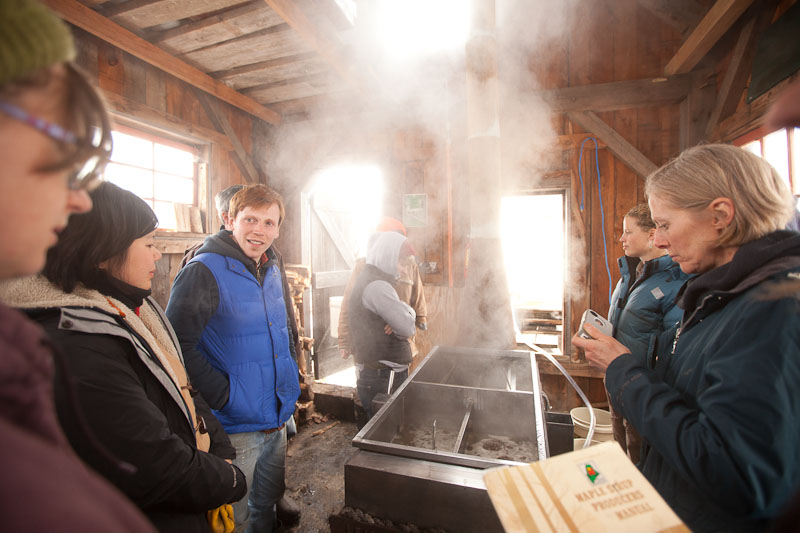 As the sap begins to boil, it progresses through an s-shaped maze of metal walls that divide the pan into open sections. Through some miracle of physics that I don’t totally grasp, the denser more syrupy liquid pushes out in front of the more watery sap and collects in a finishing chamber. Once that sap reaches the right consistency (66% sugar, which you measure with a hydrometer), it’s now syrup – for about ten seconds before it burns to a caramel mass at the bottom of the pan, so draw it out fast! Filter out the particulates (called sugarsand or nitter) and put it up in pretty jars. Admire.
As the sap begins to boil, it progresses through an s-shaped maze of metal walls that divide the pan into open sections. Through some miracle of physics that I don’t totally grasp, the denser more syrupy liquid pushes out in front of the more watery sap and collects in a finishing chamber. Once that sap reaches the right consistency (66% sugar, which you measure with a hydrometer), it’s now syrup – for about ten seconds before it burns to a caramel mass at the bottom of the pan, so draw it out fast! Filter out the particulates (called sugarsand or nitter) and put it up in pretty jars. Admire. 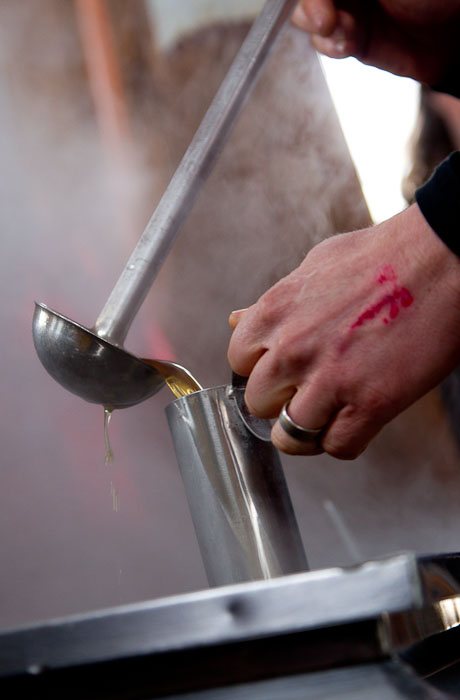 And you’re done! After six-week’s worth of hauling hundreds of gallons of sap and burning through cord upon cord of firewood, you’ll have 40 gallons of syrup if you’re cranking on a tiny evaporator like ours. Not to be a downer, but a gallon of the stuff sells for roughly $60, so that’s just $2,400 gross revenue for all that work.But take heart instead in sweet memories of cold March nights spent hanging with friends in the cozy glow of a wood-fired sugar shack, laughing and making something that “tastes like happiness,” as Kim Rich, fellow maple sugar foodie and mad scientist quite rightly pointed out as we sampled the product of so much labor.
And you’re done! After six-week’s worth of hauling hundreds of gallons of sap and burning through cord upon cord of firewood, you’ll have 40 gallons of syrup if you’re cranking on a tiny evaporator like ours. Not to be a downer, but a gallon of the stuff sells for roughly $60, so that’s just $2,400 gross revenue for all that work.But take heart instead in sweet memories of cold March nights spent hanging with friends in the cozy glow of a wood-fired sugar shack, laughing and making something that “tastes like happiness,” as Kim Rich, fellow maple sugar foodie and mad scientist quite rightly pointed out as we sampled the product of so much labor.
